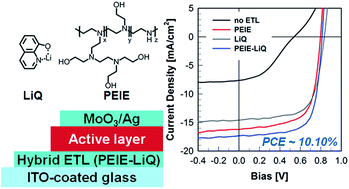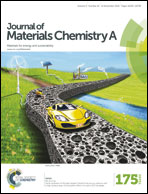High performance polymer solar cells employing a low-temperature solution-processed organic–inorganic hybrid electron transport layer†
Abstract
Interfacial engineering of polymer solar cells is regarded as an effective method to enhance the photovoltaic performance of polymer solar cells. In light of this, we prepared a novel organic–inorganic hybrid electron transport layer (ETL) composed of polyethyleneimine ethoxylate and a lithium quinolate complex, and investigated its effect on device performance. The properties of the hybrid ETL that are favorable for solar cell applications include solution processability, high optical transparency, smooth film morphology and work function tunability, which resulted in improved charge generation and suppressed charge recombination. Devices employing the hybrid ETL generated a promising power conversion efficiency of 10.10% with high ambient stability. Furthermore, the hybrid ETL showed good mechanical properties with high reproducibility at a large active area. Thus, the hybrid ETL is a promising candidate ETL for high performance polymer solar cells.


 Please wait while we load your content...
Please wait while we load your content...